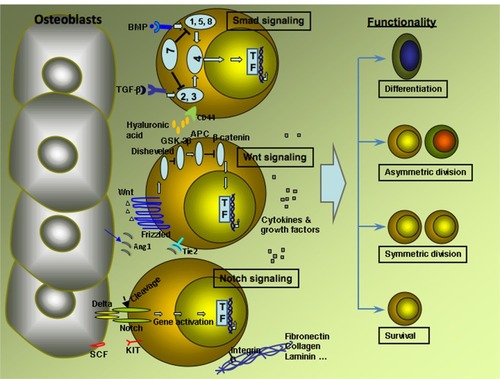Figures & data
Table 1 Clinical trials using bone marrow derived cells
Figure 1 Major signaling pathways and factors influence HSCs fate in vivo.
Notes: The Smad signaling: BMP or TGF-β binds to surface receptors expressed on HSCs, which activate receptor regulated Smad (r-Smad), Smad 1, 5, 8 or Smad 2, 3 respectively. Activated r-Smad binds to Smad 4 and forms a complex, which enters to the nucleus and activate variety of genes.The canonical Wnt signaling: Wnt binds to surface receptors of the Frizzled family protein expressed on HSCs. Then the receptors activate Disheveled family protein, which in turn inhibit glycogen synthase kinase (GSK-3) and adenomatosis polyposis coli (APC). This inhibition stabilizes β-catenin and leads to the activation of transcription factors through β-catenin. Notch signaling: the extracellular domain of Notch signaling receptor binds to Jagged or Delta proteins expressed on osteoblasts. Upon binding, intracel-lular domain of Notch receptor undergoes cleavage and enters to the nucleus, which regulates a variety of genes. Other factors that influence the fate decision of HSCs include cytokines and growth factors, integrin binding to extracellular matrix molecules, SCF, Ang1, CD44 etc, which function as either enhancing the survival ability of HSCs or mediating cell division or inducing differentiation.
